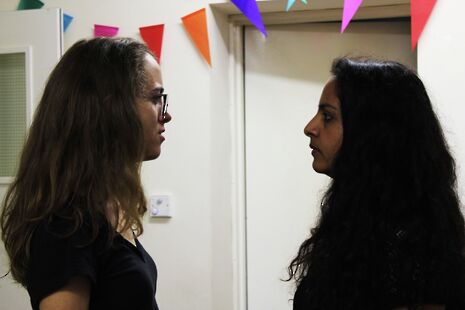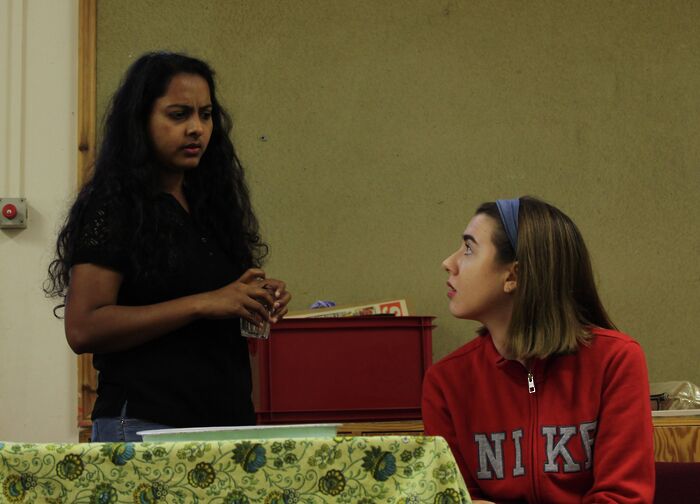Next To You I Lie review: ‘it is the actresses who triumph’
With an interesting mode of staging and standout acting, our reviewer believes this latest Madhouse offering shouldn’t be missed.

There is a beautiful tension in the way the four women hold themselves in the final scene of this play, a corporeal stillness which no single opinion cannot resolve. They are four female bodies asserting their right to choose but also their right to change.
The setting is intimate, the audience and actors crammed together in the square of Murray Edwards bar, hemmed in by high walls and the balcony which leaves no space unseen. The mirror leaning against the wall becomes the site of female bonding, as Juliet watches her mother get ready for a night working at the bar, gossiping about the man she might bring home, as Juliet and Sian sing along to ‘Faith’, doing their makeup on their way to a night out in a scene acted with remarkably natural intimacy. The mirror is at the centre of these female relationships, ingrained into their society; being looked at is something they cannot escape.
It is the staging of the play which manages the relationships between these four characters.
The set has been wonderfully designed in two halves by Kitya Mark, with covers of playboy magazines pinned on one wall and a mirror on the other; the magazine covers hang behind Elly’s head as she meets with Juliet in the booker’s office, and line the characters’ reflections as they look at themselves in the mirror. Juliet’s life is inevitably stained by her body’s femininity. As Juliet’s mother, Paula, looks through the magazines, she turns at intervals to look at herself in the mirror, direction by Alice Tyrrell and Isla Waring which captures the tension between the objectification of these photographed naked bodies and their self-conscious impact on the women who see them.
Ananya Mishra’s Paula is full of gorgeous weariness; she speaks to an empty bar, staring into the distance as she strips away the layers of fancy dress and hospitality smile and is left with her true sadness. The play watches her descend from youthful gossip to despair and even fear; Ananya hits each movement of this choreography perfectly. She is defiant in the face of Elly, played by Iulia Teodorescu with an impressive scorn of both female naivety and male hunger which hides (to a lesser and lesser degree as the play goes on) a much more sympathetic side, one which is almost brought to tears when she thinks about the young girls who send in their photographs – and which wrenches the audience, too. Sophie Atherton’s Sian grows in solemnity as the drama plays out, beginning as the best friend who puts on makeup with Juliet and compliments her figure, and ending as the one who recognises the sordid reality of the industry – the one who champions change. Hers is a story told with shame, but also with determination.
Juliet’s character, however, is much less linear. Thea Mead presents a girl buoyed up by a Page Three assertion of her beauty, quickly disillusioned by the industry and the impossibility of the kind of success she craves, but by the end of the play elevated once again by the need to defend the men’s magazine shoots and to ward off her mother’s feeling of disgust. She must remain sure of herself if the tension in the final scene is to hold – and Thea captures this self-deceiving certainty exactly.
And it is the staging of the play which manages the relationships between these four characters. Ideas about space are central to the scenes, allowing or denying intimacy, drawing the focus onto the female bodies. In the opening scenes the characters sit casually, they embrace and dance around with each other; by the end, they stand rigidly apart from one another, circling around the table with the magazines on it, treating the others’ bodies as alien shapes, awkward and disgusting. Indeed there is disgust in this distance as this changes from a coherent, intertwined society of women to one which, through the controversial and the sordid, drives them apart into their separate opinions. The space between them at the end of the play is the space where the men fit in. There is only so far these women can go. For now at least, the play must end here, as we wait for men to speak up, to defend themselves and their ‘dark side’, and to accuse instead the industry which so drives and corrupts their desires.
But as far as this play is concerned it is the actresses who triumph, presenting characters with depth and complexity, and a beauty beyond the mirror which makes us hang onto their every word. You shouldn’t miss it.
Next To You I Lie is on at Murray Edwards Bar until 15 June
 Interviews / ‘People just walk away’: the sense of exclusion felt by foundation year students19 April 2024
Interviews / ‘People just walk away’: the sense of exclusion felt by foundation year students19 April 2024 News / Controversy on the Cam: John’s spend almost 90 times more on rowing than other colleges19 April 2024
News / Controversy on the Cam: John’s spend almost 90 times more on rowing than other colleges19 April 2024 Theatre / The closest Cambridge comes to a Drama degree 19 April 2024
Theatre / The closest Cambridge comes to a Drama degree 19 April 2024 News / Corpus student left with dirty water for over six months21 April 2024
News / Corpus student left with dirty water for over six months21 April 2024 News / Emmanuel College cuts ties with ‘race-realist’ fellow19 April 2024
News / Emmanuel College cuts ties with ‘race-realist’ fellow19 April 2024






